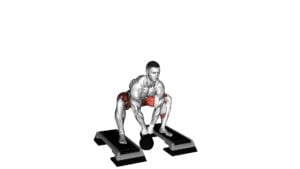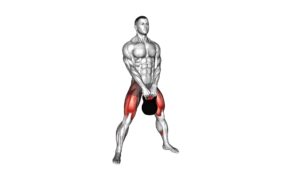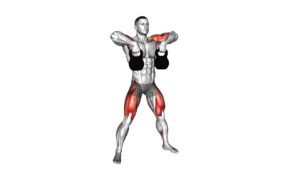Kettlebell Sumo Squat (male) – Video Exercise Guide & Tips

Are you looking for an effective lower body exercise? Look no further than the kettlebell sumo squat.
Watch This Exercise Video
This video exercise guide and tips will show you the proper technique and help you maximize your results.
Get ready to tone and strengthen your glutes, quads, and hamstrings.
Whether you're a beginner or advanced, this exercise can be modified to suit your fitness level.
Grab your kettlebell and get ready to squat your way to stronger legs.
Key Takeaways
- Kettlebell sumo squat targets quadriceps, glutes, hamstrings, calves, and inner thigh muscles, increasing strength and mobility.
- Proper foot placement with feet wider than shoulder-width apart and toes slightly turned out is important for stability and engagement of glutes and inner thigh muscles.
- Maintaining proper hip and knee alignment, with knees in line with toes, reduces stress on joints and ensures effective execution of the exercise.
- Gradually increasing weight, incorporating advanced variations, and circuit training can increase intensity and progression of the kettlebell sumo squat.
Benefits of the Kettlebell Sumo Squat
You can experience increased strength and mobility by incorporating the Kettlebell Sumo Squat into your workout routine. This exercise is highly effective in improving lower body strength, targeting your quadriceps, glutes, hamstrings, and calves. The wide stance of the sumo squat engages your inner thigh muscles as well.
One of the major benefits of the Kettlebell Sumo Squat is its versatility. There are several variations of the sumo squat that you can incorporate into your routine to target different muscle groups and add variety to your workouts. For example, you can perform the goblet sumo squat by holding a kettlebell with both hands at chest level, which also engages your core muscles. Another variation is the single-arm kettlebell sumo squat, where you hold the kettlebell with one hand at your side, challenging your stability and balance.
In addition to improving lower body strength, the Kettlebell Sumo Squat also helps to increase mobility in your hips and ankles. This exercise requires you to maintain a wide stance, which helps to improve your hip mobility and flexibility. It also strengthens the muscles around your ankles, which is beneficial for activities that require stability and balance.
Incorporating the Kettlebell Sumo Squat into your workout routine can provide numerous benefits, including improved lower body strength, increased mobility, and greater muscle engagement. By trying different variations of the sumo squat, you can target specific muscle groups and add variety to your workouts. So, grab a kettlebell and start incorporating this effective exercise into your routine for stronger and more mobile lower body muscles.
Proper Set-Up and Starting Position
When performing the kettlebell sumo squat, proper foot placement is crucial for maintaining stability and balance throughout the exercise. Your feet should be positioned wider than shoulder-width apart, with your toes slightly turned out.
This stance helps to engage the inner thigh muscles and allows for proper alignment of the hips and knees, reducing the risk of injury.
Foot Placement Importance
Achieving proper foot placement is crucial for executing the kettlebell sumo squat effectively and safely. The way you position your feet can greatly impact your form and the effectiveness of the exercise. Here are three important considerations for foot placement:
- Width: Stand with your feet wider than shoulder-width apart to create a stable base of support.
- Toes: Point your toes slightly outward to engage your glutes and inner thigh muscles.
- Weight Distribution: Ensure that your weight is evenly distributed between both feet to maintain balance and stability throughout the movement.
By following these guidelines, you can optimize your foot placement and enhance the benefits of the kettlebell sumo squat.
Hip and Knee Alignment
To ensure proper hip and knee alignment in the kettlebell sumo squat, it's important to establish a proper set-up and starting position. Correct knee alignment is crucial for preventing injuries and maximizing the effectiveness of the exercise.
When setting up for the sumo squat, position your feet wider than shoulder-width apart, with your toes pointing slightly outward. As you lower into the squat, focus on keeping your knees in line with your toes. Avoid allowing your knees to collapse inward or push too far forward.
Maintaining proper knee alignment helps distribute the load evenly and reduces stress on the joints, minimizing the risk of strains or tears. By prioritizing knee alignment, you can perform the kettlebell sumo squat safely and efficiently.
Step-by-Step Guide to Performing the Exercise
Now let's focus on the key points of performing the kettlebell sumo squat.
You'll learn about the proper form tips to ensure you're executing the exercise correctly.
We'll also discuss common mistakes to avoid, so you can maximize the effectiveness of this exercise.
Proper Form Tips
Start by positioning your feet wider than shoulder-width apart and turn your toes out slightly. This stance will allow for greater stability and engagement of the lower body muscles during the kettlebell sumo squat exercise.
Here are some proper form tips to help you improve your technique and maximize muscle activation:
- Keep your back straight: Maintain a neutral spine throughout the movement to avoid placing unnecessary strain on your lower back.
- Engage your core: Tighten your abdominal muscles to provide stability and support during the exercise.
- Descend into a deep squat: Lower your body by bending at the hips and knees, aiming to have your thighs parallel to the ground or slightly below.
Common Mistakes to Avoid
What are some common mistakes to avoid when performing the kettlebell sumo squat exercise? To ensure proper technique and maximize the effectiveness of this exercise, it's important to be aware of these common mistakes.
Firstly, avoid rounding your back during the squat. This can put unnecessary strain on your lower back and increase the risk of injury. Instead, maintain a neutral spine throughout the movement.
Secondly, be mindful of your knee position. Avoid letting your knees cave inwards as you squat. To prevent this, engage your glutes and keep your knees in line with your toes.
Lastly, avoid rushing through the exercise. Take your time and focus on maintaining proper form and control.
By avoiding these common mistakes, you'll be able to perform the kettlebell sumo squat safely and effectively, reaping the benefits of this exercise.
Transition sentence: Now that you're aware of the common mistakes to avoid, let's explore the benefits of the kettlebell sumo squat exercise.
Benefits of This Exercise
To maximize the effectiveness of the kettlebell sumo squat exercise and achieve its full benefits, focus on maintaining proper form and control throughout the movement. This exercise offers several advantages for lower body strength training.
Here are three key benefits:
- Muscle activation: The kettlebell sumo squat targets multiple muscle groups, including the quadriceps, hamstrings, glutes, and core. This exercise helps to strengthen and tone these muscles, leading to improved overall lower body strength.
- Variation for lower body strength training: The sumo squat variation with a kettlebell adds an extra challenge to traditional squats. By holding the kettlebell in front of your body, you engage your upper body muscles as well, making it a more comprehensive exercise for overall strength development.
- Increased calorie burn: The kettlebell sumo squat is a compound exercise that involves multiple muscle groups, leading to a higher calorie burn. This makes it an effective exercise for weight loss and improving cardiovascular fitness.
Incorporating the kettlebell sumo squat into your workout routine can provide numerous benefits for lower body strength training and overall fitness.
Common Mistakes to Avoid
Avoid leaning too far forward during the kettlebell sumo squat exercise, as this can put strain on your lower back and compromise your form. To avoid injury and maximize results, it's important to maintain proper technique throughout the exercise. Leaning forward excessively can shift the load onto your lower back, increasing the risk of strain or discomfort in that area. Instead, focus on keeping your chest up and your back straight, engaging your core muscles to support your spine. By doing so, you'll distribute the weight evenly and target the intended muscles more effectively.
Another common mistake to avoid isn't going low enough in the squat. When performing the kettlebell sumo squat, it's essential to lower your body until your thighs are parallel to the ground. This allows for a full range of motion and engages the muscles in your legs and glutes more effectively. Going too shallow in the squat limits the activation of these muscles and reduces the overall effectiveness of the exercise.
Lastly, be cautious not to rush through the movement. Slow and controlled movements are key to maximizing your results and preventing injury. Take your time to descend into the squat and then drive through your heels to return to the starting position. This deliberate pace will ensure proper form and engage the muscles throughout the entire exercise.
Tips for Increasing Intensity and Progression
To increase the intensity and progression of the kettlebell sumo squat exercise, focus on gradually increasing the weight of the kettlebell you use. This will help to challenge your muscles and stimulate growth. Here are some tips to help you increase the intensity and progression of your kettlebell sumo squat:
- Increasing Resistance: Start with a kettlebell that you can comfortably lift for 8-12 reps. As you get stronger, gradually increase the weight of the kettlebell to continue challenging your muscles. Aim to add 2-5 pounds every 1-2 weeks to ensure steady progression.
- Advanced Variations: Once you have mastered the basic kettlebell sumo squat, you can incorporate advanced variations to further increase the intensity. Try adding a pulse at the bottom of the squat, or perform the exercise on an unstable surface like a BOSU ball to engage your stabilizing muscles.
- Circuit Training: Incorporating the kettlebell sumo squat into a circuit training routine can also help to increase the intensity and progression. Combine it with other compound exercises like kettlebell swings, lunges, or push-ups for a full-body workout that will challenge your strength and endurance.
Safety Precautions and Modifications
When it comes to performing the kettlebell sumo squat exercise, it's important to prioritize safety and make any necessary modifications to ensure proper form and prevent injuries.
Safety should always be the top priority when engaging in any exercise routine. To ensure your safety while performing the kettlebell sumo squat, it's crucial to maintain proper form throughout the exercise. This includes keeping your back straight, knees aligned with your toes, and maintaining a stable core.
It's also essential to choose an appropriate weight for your fitness level to avoid strain or injury. If you're new to kettlebell exercises or have any existing injuries or limitations, it's recommended to consult with a fitness professional or physical therapist for guidance on modifications. They can provide you with alternative exercises or adjustments to accommodate your specific needs and ensure a safe and effective workout.
Frequently Asked Questions
How Many Calories Does the Kettlebell Sumo Squat Burn?
The number of calories burned during a kettlebell sumo squat will depend on various factors such as your weight and intensity level.
However, incorporating kettlebell sumo squats into your workout routine can be beneficial. It targets multiple muscle groups, including your legs, glutes, and core, helping to improve strength and stability.
Additionally, the explosive movement involved in the exercise can increase your heart rate and contribute to calorie burn.
Can the Kettlebell Sumo Squat Help With Weight Loss?
The kettlebell sumo squat can be a helpful exercise in your weight loss journey. By incorporating this exercise into your fitness routine, you can benefit from its weight loss benefits.
The kettlebell sumo squat is an effective exercise for toning your lower body muscles, including your glutes, quads, and hamstrings. It can also increase your overall strength and improve your balance.
Consistency and proper form are key to maximize the effectiveness of this exercise.
How Often Should I Perform the Kettlebell Sumo Squat for Optimal Results?
For optimal results, you should perform the kettlebell sumo squat with the right frequency.
The frequency of your kettlebell sumo squat sessions will depend on your fitness goals and current fitness level.
It's recommended to start with two to three sessions per week and gradually increase it as you progress.
Additionally, you can vary the sumo squat by using different kettlebell weights or trying different variations, such as the goblet sumo squat or the kettlebell swing.
Can the Kettlebell Sumo Squat Help Improve Flexibility?
The kettlebell sumo squat can definitely help improve your flexibility. By incorporating this exercise into your routine, you'll be able to target multiple muscle groups while also increasing your range of motion.
The wide stance in the sumo squat allows for a deeper stretch in your hips, groin, and inner thighs, promoting flexibility in these areas. Additionally, there are various kettlebell sumo squat variations that you can try to further challenge and enhance your flexibility.
Is It Necessary to Use a Kettlebell for the Sumo Squat, or Can I Use Other Types of Weights?
Using alternative weights for the sumo squat is possible, but using a kettlebell offers unique benefits.
The kettlebell's shape and handle allow for a more comfortable grip and better control during the exercise.
Additionally, the off-center weight distribution of the kettlebell engages more muscles, increasing the intensity and effectiveness of the squat.
Conclusion
Incorporating kettlebell sumo squats into your workout routine can provide numerous benefits. This exercise is especially effective for strengthening your lower body, improving balance, and increasing overall power and stability. To ensure proper form and maximize the effectiveness of this exercise, it's important to follow the proper set-up and starting position. Here is a step-by-step guide to help you perform kettlebell sumo squats correctly:
- Begin by standing with your feet wider than shoulder-width apart and toes pointed slightly outward.
- Hold a kettlebell with both hands, allowing it to hang in front of your body.
- Engage your core muscles and keep your chest lifted throughout the exercise.
- Bend your knees and lower your body down into a squat position, keeping your weight in your heels.
- As you lower down, make sure your knees track in line with your toes and avoid letting them collapse inward.
- Continue lowering until your thighs are parallel to the ground, or as low as you can comfortably go.
- Push through your heels and engage your glutes and quadriceps to rise back up to the starting position.
- Repeat for the desired number of repetitions.
To get the most out of kettlebell sumo squats, it's important to avoid common mistakes. These include rounding your back, allowing your knees to cave inward, or not fully engaging your glutes and core muscles. Gradually increase the intensity of this exercise by using heavier kettlebells or adding more repetitions or sets. Finally, prioritize safety precautions by using proper form, starting with a weight that you can comfortably handle, and listening to your body for any signs of pain or discomfort. Start incorporating kettlebell sumo squats into your workouts today to reap the benefits and see progress in your fitness journey.

Author
Years ago, the spark of my life’s passion ignited in my mind the moment I stepped into the local gym for the first time. The inaugural bead of perspiration, the initial endeavor, the very first surge of endorphins, and a sense of pride that washed over me post-workout marked the beginning of my deep-seated interest in strength sports, fitness, and sports nutrition. This very curiosity blossomed rapidly into a profound fascination, propelling me to earn a Master’s degree in Physical Education from the Academy of Physical Education in Krakow, followed by a Sports Manager diploma from the Jagiellonian University. My journey of growth led me to gain more specialized qualifications, such as being a certified personal trainer with a focus on sports dietetics, a lifeguard, and an instructor for wellness and corrective gymnastics. Theoretical knowledge paired seamlessly with practical experience, reinforcing my belief that the transformation of individuals under my guidance was also a reflection of my personal growth. This belief holds true even today. Each day, I strive to push the boundaries and explore new realms. These realms gently elevate me to greater heights. The unique combination of passion for my field and the continuous quest for growth fuels my drive to break new ground.







